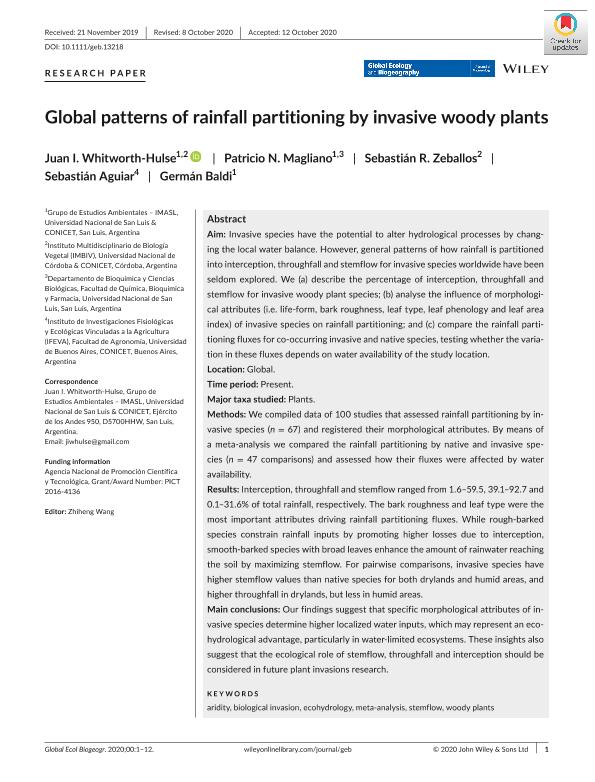Artículo
Global patterns of rainfall partitioning by invasive woody plants
Whitworth Hulse, Juan Ignacio ; Magliano, Patricio Nicolás
; Magliano, Patricio Nicolás ; Zeballos, Sebastián Rodolfo
; Zeballos, Sebastián Rodolfo ; Aguiar, Sebastián
; Aguiar, Sebastián ; Baldi, Germán
; Baldi, Germán
 ; Magliano, Patricio Nicolás
; Magliano, Patricio Nicolás ; Zeballos, Sebastián Rodolfo
; Zeballos, Sebastián Rodolfo ; Aguiar, Sebastián
; Aguiar, Sebastián ; Baldi, Germán
; Baldi, Germán
Fecha de publicación:
11/2020
Editorial:
Wiley Blackwell Publishing, Inc
Revista:
Global Change Biology
ISSN:
1354-1013
Idioma:
Inglés
Tipo de recurso:
Artículo publicado
Clasificación temática:
Resumen
Aim: Invasive species have the potential to alter hydrological processes by changing the 7 local water balance. However, general patterns of how rainfall is partitioned into 8 interception, throughfall and stemflow for invasive species worldwide have been 9 seldom explored. We (a) describe the percentage of interception, throughfall and 10 stemflow for the invasive woody plant species; (b) analyse the influence of 11 morphological attributes (i.e., life-form, bark roughness, leaf type, leaf phenology and 12 leaf area index) of invasive species on rainfall partitioning; and (c) compare the rainfall 13 partitioning fluxes for co-occurring invasive and native species, testing whether these 14 fluxes variation depends on water availability of the study location. 15Location: Global. 16Time period: Present. 17Major taxa studied: Plants. 18Methods: We compiled data of 100 studies that assessed rainfall partitioning by 19 invasive species (N=67) and registered their morphological attributes. By means of a 20 meta-analysis we compared the rainfall partitioning by native and invasive species 21 (N=47 comparisons) and assessed how their fluxes were affected by water availability. 22Results: Interception, throughfall and stemflow ranged from 1.6 - 59.5%, 39.1 - 92.7% 23 and 0.1 - 31.6% of total rainfall, respectively. The bark roughness and leaf type were the 24 most important attributes driving rainfall partitioning fluxes. While rough-barked 25 species constrain rainfall inputs by promoting higher losses due to interception, smooth-26 barked species with broadleaves enhance the amount of rainwater reaching the soil by 27 maximizing stemflow. For pair-wise comparisons, invasive species have higher 28 stemflow values than native species for both drylands and humid areas, and higher 29 throughfall in drylands, but less in humid areas. 30Main conclusions: Our findings suggest that specific morphological attributes of 31 invasive species determine higher localized water inputs, which may represent an 32 ecohydrological advantage, particularly in water-limited ecosystems. These insights 33also suggest that the ecological role of stemflow, throughfall and interception should be 34 considered in future plant invasions research. 3536
Palabras clave:
BIOLOGICAL INVASION
,
META-ANALYSIS
,
ECOHYDROLOGY
,
STEMFLOW
,
WOODY PLANTS
,
ARIDITY
Archivos asociados
Licencia
Identificadores
Colecciones
Articulos(IFEVA)
Articulos de INST.D/INV.FISIOLOGICAS Y ECO.VINCULADAS A L/AGRIC
Articulos de INST.D/INV.FISIOLOGICAS Y ECO.VINCULADAS A L/AGRIC
Articulos(IMASL)
Articulos de INST. DE MATEMATICA APLICADA DE SAN LUIS
Articulos de INST. DE MATEMATICA APLICADA DE SAN LUIS
Articulos(IMBIV)
Articulos de INST.MULTIDISCIPL.DE BIOLOGIA VEGETAL (P)
Articulos de INST.MULTIDISCIPL.DE BIOLOGIA VEGETAL (P)
Citación
Whitworth Hulse, Juan Ignacio; Magliano, Patricio Nicolás; Zeballos, Sebastián Rodolfo; Aguiar, Sebastián; Baldi, Germán; Global patterns of rainfall partitioning by invasive woody plants; Wiley Blackwell Publishing, Inc; Global Change Biology; 30; 1; 11-2020; 1-12
Compartir
Altmétricas



